|
International Hand Launch Glider Festival June 3-4, 2001 |
|
| Flaps Flaps are used for control of descent as well as to control speed. Most of the aileron ships at the IHLGF were flaperon ships. Using flaperons, the pilot can control the roll axis as well as the camber of the airfoil, to adjust the plane to the flying conditions. When flaperons are used, the camber and thickness of the airfoils are often reduced. The flaperons can increase the camber, and hence the airfoil's lifting ability, while the thin sections permits a faster, low drag airfoil section, when the camber is reduced. Flaps, on the other hand can be used
to control only speed. There were three ships with separate
flaps, (Raptors, Feathers, and the Watson Sidewinder and of these,
only the Watson Sidewinder is a polyhedral plane.
|
|
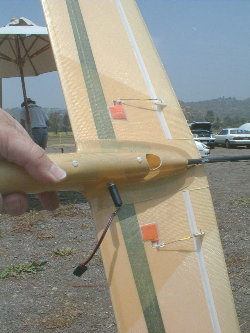 |
Here is the underside of Encore flaperons ship produced by Maple Leaf Designs. Two servos controlled separate flaperons. The wing here is hinged on the top surface with the Kevlar layer. The open gap of the flaperon was sealed with a thin mylar sheet which overlapped the flaperon surface. |
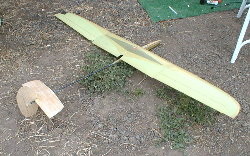 |
Here is one of the first separate flap and aileron ships. This is the original Feather, designed by Brian Buass of RaptorRC.com. The straight center section used one servo to control the center flap. The groove in the flap is to prevent the flap from hitting the tailboom when the flap is down. Adding another servo adds weigh to the plane, and also may require an increase in battery size. This ship used 5 servos: Rudder, Elevator, Right Aileron, Left Aileron, and Flap. |
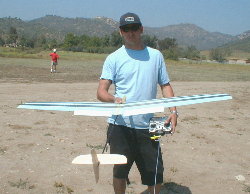 |
Paul Anderson displays the new full house hand launch Raptor,designed by Brian Buass of RaptorRC.com. the plane used 6 servos and can be envisioned as just a very small open class ship. Paul set up this Raptor with crow, the flaps go down and the ailerons go up. It was very interesting and fun to watch Paul launch (he was among the highest launchers at the contest). Paul's plane would climb out, then drop the flaps and down the plane would come to land. |
 |
Here is the underside of the Raptor flown by Paul Anderson. The flaps are shown deployed. Paul set his ship up for CROW, just like a large TD ship. However, the small size and weight of the HLG permits the ship to respond quickly to control surface inputs. |
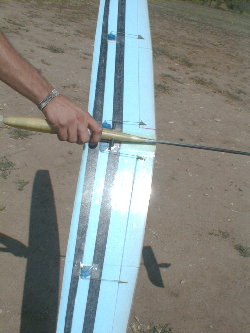 |
Here is the underside of the Raptor flown by Paul Anderson. The flaps are shown in the normal flying position. |
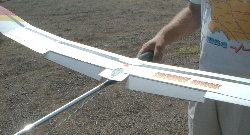 |
The only flapped polyhedral ship was flown by Bill Watson. The picture here shows the flaps in their full down position. The flaps were controlled by a wire torque rod into the wing and flap. The flaps were connected to a servo in the nose of the plane via a pushrod. Using this configuration only one additional servo is required. Bill displayed the most control on his landing as compared to the other pilots. In fact, because of the effective use of flaps by Bill, the new polyhedral Raptors will probably have flaps added to their designs. Bill was truly on the forefront of flap use here. |
|
©2001 Crawford-Adams Enterprises All Right Reserved. |
|